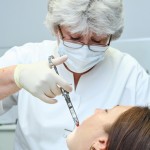
Lower third molar extraction (LTME) is a very common procedure as these teeth are often impacted resulting in a range of complications such as infection, caries, periodontal disease, tooth resorption and cyst formation. High quality pain relief is an important consideration and lidocaine and articaine are two of the most widely used local anaesthetic agents. Lidocaine has been available since 1948a review while articaine was introduced in 1976 while reviews have compared the ability of these two agents to provide pulpal anaesthesia a review of its use for LTME has not been conducted.
The aim of this review was to evaluate whether the anaesthetic efficiency of articaine is superior to that of lidocaine during lower third molar extraction (LTME).
Methods
Searches were conducted in the Medline/Pubmed, Cochrane Library and Web of Science databases. Randomised controlled trials (RCTs) comparing the effect of articaine and lidocaine published after 2005 were considered. Two reviewers independently extracted data and assessed risk of bias using the Cochrane tool.
Weighted mean differences or standardised mean differences (SMDs) with 95% confidence intervals (CI) were used to assess continuous variables and risk ratios (RR) and 95%CI for dichotomous variables and meta-analysis conducted.
Results
- 9 RCTs involving a total of 493 patients (770 third molars – 382 in lidocaine group, 388 in articaine group) were included.
- None of the studies were considered to be at low risk of bias a majority (7) having an unclear risk with 2 at high risk.
- Compared with lidocaine, 4% articaine with 1:100,000 epinephrine showed:-
- A higher success rate of anaesthesia, RR= 1.10 (95%CI; 1.01 to 1.21).
- Shorter subjective onset time of anaesthesia, SMD = 1.20 (95%CI; 0.50 to 1.89).
- Longer duration time of anaesthesia, Mean Difference = 0.83 hours (95%CI; 0.59 to 1.07 hours)
- No significant difference between articaine and lidocaine was seen for
- intraoperative pain assessment, Mean Difference = 3.12 mm (95%CI; -0.13 to 6.37 mm)
- objective onset time of anaesthesia, SMD = 0.44 (95%CI; -0.39 to 1.26)
Conclusions
The authors concluded: –
The results of this study suggest that 4% articaine with 1:100,000 epinephrine possesses superior anaesthetic efficiency relative to lidocaine for inferior alveolar nerve blocks during LTME.
Comments
The authors have searched 3 major databases and included studies in languages other than English. However, they have restricted the review to studies published after 2005 which may have excluded some relevant studies. All the included studies involved inferior alveolar nerve blocks and used 4% articaine with 1:100,000 epinephrine with all but two studies using 2% lidocaine with 1:100,000 epinephrine as a comparator the other two using 4% lidocaine with 1:100,000 epinephrine and 2% lidocaine with 1:80,000 epinephrine.
As the authors note the samples sizes of the studies are relatively small. The quality of the reporting also needs to be improved as 5 of the studies were considered to provide unclear information on randomisation and all of them were considered to be unclear in relation to reporting of allocation concealment. There is also no reporting of adverse events and further information on safety and costs would be beneficial.
Links
Primary Paper
Zhang A, Tang H, Liu S, Ma C, Ma S, Zhao H. Anesthetic Efficiency of Articaine Versus Lidocaine in the Extraction of Lower Third Molars: A Meta-Analysis and Systematic Review. J Oral Maxillofac Surg. 2018 Sep 5. pii:S0278-2391(18)30985-6. doi: 10.1016/j.joms.2018.08.020. [Epub ahead of print] Review. PubMed PMID: 30267700.
Other references
